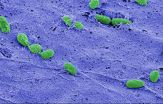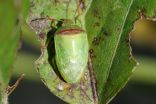(Press-News.org) HOUSTON - (Aug. 24, 2015) - Electronic triggers designed to search for key data, developed by researchers at Baylor College of Medicine and Michael E. DeBakey Veterans Affairs Medical Center, were able to identify and reduce follow-up delays for patients being evaluated for a diagnosis of colon or prostate cancer.
The full study can be found in the Journal of Clinical Oncology.
"Our computerized triggers scanned huge amounts of patient data in the electronic health record and flagged individuals at risk for delays in follow-up of cancer-related abnormal clinical findings," said Dr. Hardeep Singh, associate professor of medicine at Baylor and chief of health policy, quality & informatics program for the Center for Innovations in Quality, Effectiveness and Safety at the DeBakey Veterans Affairs Medical Center. "We created these trigger algorithms in the hopes of being able to leverage electronic health records to improve patient care and safety."
The investigators' analysis defined timely follow-up as 30 days for suspected lung cancer, 60 days for colon cancer and 90 days for prostate cancer. Many factors, including primary care workloads, time pressures and information overload, and lack of robust test result tracking systems can contribute to delays in evaluating patients whose original findings were suggestive of cancer, he said.
"There are few, if any, human- or technology-based solutions that efficiently identify such care delays," said Dr. Daniel Murphy, first author on the paper and instructor in the department of medicine and health services researcher at Baylor and the DeBakey Veterans Affairs Medical Center. "Triggers can act as safeguards as long as the information about potential delays can be communicated to clinicians taking care of these patients."
Singh and participating researchers recruited 72 primary care clinicians at two study sites for this 15-month study and divided providers into intervention and control groups. In the control group, clinicians followed up suspicious findings through usual procedures whereas in the intervention group, the study team applied triggers twice a month to all patients under their care. Triggers consider the following test results as red flags if the patient did not receive timely follow-up:
Positive fecal occult blood test
Iron deficiency anemia
Elevated prostate specific antigen
Abnormal imaging suspicious for cancer
"While all patients flagged by the computerized trigger algorithm in the intervention group are considered at risk, we confirmed the presence of delay by manually reviewing their records and communicating to their clinicians only when necessary," Singh said.
"Patients seeing clinicians who were notified of potential delays had more timely diagnostic evaluation for both prostate and colon cancer," Murphy said. "Also, more patients in the intervention part of the study had received diagnostic evaluation by the time we completed our final review."
Singh and his team are refining and exploring trigger application in other settings to detect and monitor delays and improve timeliness of cancer diagnoses.
"Missed or delayed diagnoses are among the most common patient safety concerns in outpatient settings, and measuring and reducing them are a high priority," said Singh, who also presented his team's measurement work to the Institute of Medicine (IOM) last August. This fall, the IOM plans to release a comprehensive report on diagnosis related problems.
"Solutions that harvest and put to use the vast amount of electronic clinical data being collected are essential," he said.
INFORMATION:
Others who took part in this research include: Louis Wu and Ashely N.D. Meyer, Baylor College of Medicine and Michael E. DeBakey Veterans Affairs Medical Center; Eric J. Thomas, University of Texas Houston Medical School; and Samuel N. Forjuoh, Scott and White Healthcare, Texas A&M Health Science Center, College of Medicine, Temple, Texas.
Funding for this work came from Agency for Healthcare Research and Quality (Grant #1R18HS017820) and supported in part by the Houston Veterans Affairs HSR&D Center for Innovations in Quality, Effectiveness and Safety (Grant CIN 13-413). Singh is additionally supported by the VA Health Services Research and Development Service (CRE 12-033; Presidential Early Career Award for Scientists and Engineers USA 14-274), and VA National Center for Patient Safety.
Danny has become a degenerate, that is, the tropical depression weakened. Satellite and Hurricane Hunter aircraft data showed that Danny degenerated into an elongated area of low pressure near the Windward Islands during the afternoon (local time) on August 24. Meanwhile two other developing low pressure areas lie to the east of Danny.
Satellite data from NOAA's GOES-East satellite at 14:45 UTC (10:45 a.m. EDT) on August 24, showed Danny had become stretched out into a trough of low pressure. At 11 a.m. EDT (1500 UTC), the remnants of Danny were located near latitude ...
TALLAHASSEE, Fla. -- In the second part of his lab's recent one-two punch, Florida State University researcher Daniel Kaplan said he has solved a cell division mystery in a way that will intrigue the makers of cancer-fighting drugs.
The key, said Kaplan, a College of Medicine Department of Biomedical Sciences researcher, is a protein called Treslin.
"It can target cancer cells," he said. "Most chemotherapy also targets rapidly dividing normal cells, but this seems to have promise for not doing that. Drug companies are going to be excited."
Before cells can divide, ...
SAN DIEGO, Calif. -- (Aug. 24, 2015) -- A new survey on sexual victimization issues at the University of Oregon reaffirms previous findings that there is a need to increase awareness about available services, while decreasing negative perceptions of institutional support.
Psychology professor Jennifer Freyd provided preliminary findings of the UO survey at the 20th International Summit & Training on Violence, Abuse & Trauma during a keynote session on "Campus Sexual Assault: Current Research and Prevention Approaches."
New issues also surfaced among the key findings ...
CAMBRIDGE, Mass. (August 24, 2015) - By teasing apart the structure of an enzyme vital to the infectious behavior of the parasites that cause toxoplasmosis and malaria, Whitehead Institute scientists have identified a potentially 'drugable' target that could prevent parasites from entering and exiting host cells.
Although toxoplasmosis causes disease only in certain individuals-including immunocompromised patients, pregnant women, and their infants, the T. gondii parasite is closely related to Plasmodium, which causes malaria. Research on T. gondii can provide insights ...
Commonly used antidepressant drugs change levels of a key signaling protein in the brain region that processes both pain and mood, according to a study conducted at the Icahn School of Medicine at Mount Sinai and published August 24 in the Proceedings of the National Academy of Sciences (PNAS). The newly understood mechanism could yield insights into more precise future treatments for nerve pain and depression.
The study was conducted in mice suffering from chronic neuropathic pain, a condition which is caused in mice and humans by nerve damage. Chronic neuropathic ...
Bacteria are best known as free-living single cells, but in reality their lives are much more complex. To survive in harsh environments, many species of bacteria will band together and form a biofilm--a collection of cells held together by a tough web of fibers that offers protection from all manner of threats, including antibiotics. A familiar biofilm is the dental plaque that forms on teeth between brushings, but biofilms can form almost anywhere given the right conditions.
Biofilms are a huge problem in the health care industry. When disease-causing bacteria establish ...
Atlanta, GA - August 24, 2015 - Respiratory syncytial virus (RSV), which is the leading cause of childhood respiratory hospitalizations among premature babies, can be detected from the clothes worn by caregivers/visitors who are visiting infants in the neonatal intensive care unit (NICU), according to research being presented at the International Conference on Emerging and Infectious Diseases in Atlanta, Georgia.
"The aim of this study was to identify potential sources of transmission of RSV in the NICU to better inform infection control strategies," said Dr. Nusrat ...
Atlanta, GA - August 24, 2015 - Experts show that while Middle East Respiratory Syndrome (MERS-CoV), a viral respiratory illness, is infecting less people, it has a higher mortality rate and affects a specific target population when compared to Severe Acute Respiratory Syndrome (SARS-CoV). This research is being presented at the International Conference on Emerging and Infectious Diseases in Atlanta, Georgia.
"The research conducted in this study focuses on understanding what population of individuals are most likely to become infected by MERS-CoV, compared to the population ...
BEAUMONT -- Entomologists in Texas got a whiff of a new stink bug doing economic damage to soybeans in Texas and are developing ways to help farmers combat it, according to a report in the journal Environmental Entomology.
Various types of stink bugs have long been a problem on soybean crops, but when sweeps of fields in southeast Texas netted 65 percent redbanded stink bugs, entomologists realized this particular bug had become the predominant pest problem, according to Dr. Mo Way, an entomologist at the Texas A&M AgriLife Research and Extension Center in Beaumont.
The ...
Philadelphia, PA, August 24, 2015 - Antibiotic-resistant bacteria are a concern for the health and well-being of both humans and farm animals. One of the most common and costly diseases faced by the dairy industry is bovine mastitis, a potentially fatal bacterial inflammation of the mammary gland (IMI). Widespread use of antibiotics to treat the disease is often blamed for generating antibiotic-resistant bacteria. However, researchers investigating staphylococcal populations responsible for causing mastitis in dairy cows in South Africa found that humans carried more antibiotic-resistant ...


